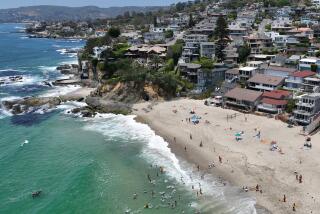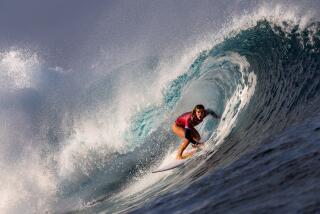Can Be Deadly for Surfers, Golding Warns : Making Waves Over Lobster Traps
SOLANA BEACH â Her manner was dignified, but the garb was decidedly casual.
Outfitted in a snug blue-and-gold wet suit, county Supervisor Susan Golding marched barefoot onto the sands of Solana Beach on Monday and immersed herself in her job. Literally.
Flanked by two lifeguards, Golding dashed into the nippy surf while conducting an afternoon press conference here. The television cameramen went wild; a half-dozen curious sunbathers abandoned their beach chairs and crept close for a peek.
But while the supervisorâs media-grabbing tactics may have seemed amusing, her message was a serious one--lobster trap lines can pose a danger to swimmers and surfers, she warned.
The issue caught Goldingâs eye last October, when surfer Brian Brokaw drowned at Carlsbad State Beach after his surfboardâs leash became entangled in a lobster trap line. In March, 1984, the same fate befell surfer Gary Decker in waters off Imperial Beach.
On Monday, as a flock of reporters looked on and a school of porpoises cavorted offshore, Golding announced the creation of a âsurf alertâ public awareness campaign designed to warn bathers that the trap lines are an underwater hazard lurking all along San Diegoâs shore.
Combining radio announcements, articles in surfing magazines and flyers in surf shops, the campaign will attempt to educate beachgoers about the hazards the lines pose and how to avoid them. Surfers, for example, can avoid problems by using quick-release leashes and by not wearing a leash under a wet suit. (The leash keeps the surfboard from getting away and is usually attached at the ankle.) Surfers also should watch for buoys, which mark the lobster traps.
In addition, the supervisor said that more than a dozen federal, state and local agencies have formed a coalition designed to enhance responses to drownings and other ocean emergencies.
The coalition, called the San Diego County Coastal Emergency Task Force, aims to improve coordination among agencies that protect the coast in an effort to âmake these waters a little safer,â Golding said.
âWhen I began looking into this last year, I discovered there was a lot of loose organization between the agencies that respond along the coast,â Golding said. âHopefully, through this task force we can develop a mutual aid network and avoid such tragedies in the future.â
Lobster season opens Wednesday and runs through March 18. On Monday, boats laying the deep-water traps, which weigh about 60 pounds and may not be baited until the season officially begins, could be seen near thick kelp beds about 500 yards offshore.
Each year, fishermen compete for highly coveted trapping permits through a lottery held by the state Department of Fish and Game, which oversees the industry and is charged with nabbing poachers. About 200 permits will be issued this season in San Diego County, where more than 90,000 lobsters--roughly 39% of the stateâs total legal commercial catch--were snared in 1984.
Long lines are attached to buoys that mark the location of the traps for fishermen. Normally, they do not pose a problem to bathers because the traps are placed about 400 yards beyond the surf zone, according to county Lifeguard Services Capt. Andrew OâLeary.
âBut when we get heavy winter swells, the traps have a propensity to skid toward the shore and drift around with the current,â OâLeary said. âThatâs when we get trouble.â
The long lines can become entangled in a surferâs leash and the weight of the traps, large steel cages with bricks inside, can pull a swimmer downward, OâLeary said. He said about 100 traps wash up on North County beaches during an average season.
In years past, state regulations have prohibited lifeguards from removing loose traps from the surf. Only Fish and Game wardens had such authority. But Golding said Monday that the state Fish and Game Commission has agreed to permit lifeguards to pluck traps from the ocean if they âpose a public danger.â She also intends to push for changes in regulations governing the industry, such as requiring fishermen to attach identification tags to their traps to establish liability in case of accidents.
More to Read
Sign up for Essential California
The most important California stories and recommendations in your inbox every morning.
You may occasionally receive promotional content from the Los Angeles Times.










